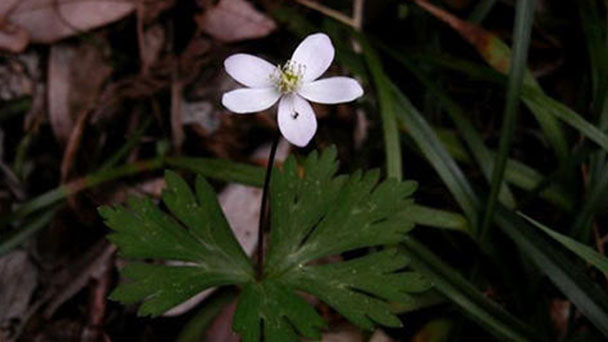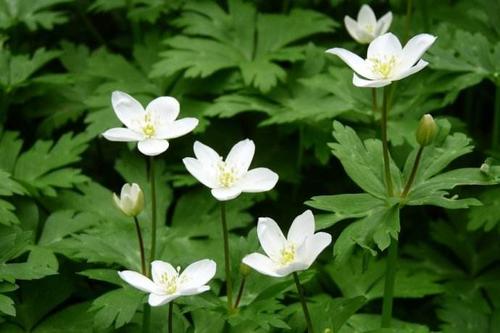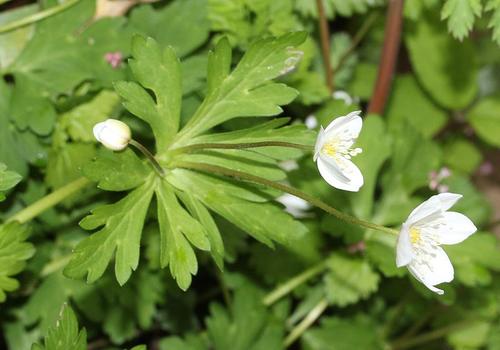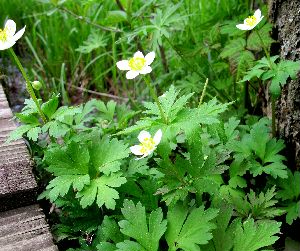Anemone flaccida (flaccid anemone) profile
Written by Maggie
Mar 10 2021

Anemone flaccida, commonly called flaccid anemone, is a perennial herb of the genus Anemone in the Ranunculaceae, with plants up to 40 cm tall. Anemone flaccida rhizome is oblique, subterete, basal leaves long stalked; Leaf blade is thinly herbaceous, pentagonal, surface sparsely glabrous, abaxially usually glabrous or sub glabrous, veins flat; Petiole of Anemone flaccida is glabrous or sub glabrous. Scape sparsely pubescent only distally; Bracts are basal-like leaves, sessile, rhomboid triangular or rhomboid, pedicels sparsely pubescent; Sepals are white, obovate or elliptic, anthers elliptic, flowers filiform;
Anemone Flaccida is distributed in northwestern Yunnan, Sichuan, Guizhou, western Hubei, Hunan, Jiangxi, northwestern Zhejiang, southern Jiangsu, southern Shaanxi, and southern Gansu in China. Grassland or undergrowth in mountain valleys. It is also found in Japan and the Russian Far East.
Anemone Flaccida is suitable for flower beds and flower borders. In addition, the rhizomes can be used medicinally.
Anemone flaccida picture

Morphological characteristics of Anemone flaccida
Rhizome
Anemone flaccida is a perennial herb with plants 15 -- 40 cm tall. Rhizome is oblique, subcylindrical, thick (2.5-)5 -- 10 mm, internodes shortened.
Leaf
Basal leaves of Anemone flaccida are 1-2, long stipitate; Leaf blade is thin-herbaceous, pentagonal, 3.5 -- 7.5 cm long, 6.5 -- 14 cm wide, base deeply cordatate, trifid, middle whole lobes rhomboid, trifid, final lobes ovate or broadly lanceolate, 1-3 teeth or entire, lateral whole lobes unequal, surface sparsely glabrous, abaxially usually glabrous or subglabrous, veins flat; Petiole is 10-28 cm long, glabrous or subglabrous.
Flowers
The scapes of anemone flaccida have pubescent hairs only distally; Anemone flaccida has 3 bracts, basal-like leaves, sessile, unequal, rhomboid triangular or rhomboid, 4.5 -- 6 cm long, trifid; Anemone flaccida has 2-3 pedicels, 4.2 -- 7.5 cm long, pubescent; Anemone flaccida has 5 sepals, white, obovate or elliptic, 7 -- 10 mm long, 4 -- 5.5 mm wide, tip obtuse or rounded, outside sparsely pubescent; Stamens are half sepals long, anthers elliptic, ca. 0.8 mm long, filiform; Carpel ca. 8, ovary densely pale yellow pubescent, style free, stigmas sub triangular.
Ecological habits of Anemone Flaccida
Anemone Flaccida likes cool, moist, sunny environments, relatively cold resistance, and avoids high temperature and humidity.
Anemone Flaccida prefers moist, well-drained, fertile loam soil.

Variety classification of Anemone flaccida
Anemone flaccida (variety)
Scientific name: Anemone Flaccida var. Hirtella W. T. Wang in Addenda.
Leaf blade thick, herbaceous, veins ascending abaxially;Petioles and scapes densely puberulent;Inflorescences have 5 flowers.
Lichuan, Hubei Province.Health 1000 meters above sea level along the mountain ditch.
Anemone flaccida (variety)
Latin name: Anemone Flaccida var. hofengensis Wuzhi
Leaf blade thick, herbaceous, veins ascending abaxially;Inflorescences with (4-) 5-6 flowers;Bracts deeply divided, lobes more or less lobed.Plants often tall, up to 63 cm;Basal leaves up to 6.2 cm long and 12 cm wide.Petiole and scapes sparsely pubescent only distally.Distribution in northwest Hunan (Sangzhi), southwest Hubei (Enshi, Hefeng), eastern Sichuan (Fengjie).Living at an altitude of 1200-1400 meters between mountain gullies or grassy slopes.
The distribution of Anemone Flaccida
In China, Anemone Flaccida is distributed in northwestern Yunnan (3000 m above sea level), Sichuan (1700 m above sea level), Guizhou (1100-1800 m), western Hubei, Hunan, Jiangxi, northwestern Zhejiang, southern Jiangsu, southern Shaanxi (1100-1200 m), and southern Gansu (up to 2600 m).
Anemone Flaccida is also distributed in Japan and the Far East of the Soviet Union.
Anemone flaccida uses
Medicinal value
The main chemical constituents of Anemone Flaccida are saponins, and the aglycones of Anemone Flaccida are mainly oleanolic acid and ivy saponin. A variety of soap compounds have been obtained from studies.In addition, there are flavonoids, coumarins, organic acids, endophytes and volatile oils and other chemical constituents. Studies have shown that as a medicinal plant, this plant has different degrees of inhibitory effect on in vitro cancer cells and has anti-tumor effect. Anemone flaccida active ingredients are mainly saponins, which have different degrees of effects on anti-inflammatory, antibacterial, analgesic and sedative, anticonvulsant and antihistamine, and anti-oxidation, as well as some other pharmacological activities.
The rhizome is used medicinally to treat injuries caused by falls.
Rhizome: symplectic, slightly bitter, warm. Dispel wind and dampness, strengthen muscles and bones.For injuries caused by falls, rheumatic pain.
Landscape use of Anemone Flaccida
Anemone Flaccida has elegant leaves, green leaves and delicate flowers. It is suitable for flower beds and flower borders. Anemone flaccida is also suitable to be planted in patches under sparse forests or on the edge of lawns.

Latest Updated
- Benefits of Bugleweed - 7 Science-backed Health Benefits
- Bugleweed Dangers & Side Effects - Is It Poisonous?
- How to Plant Evergreen Trees - What You Should Know
- When to Plant Evergreens - Grow Guide for Evergreen Trees
- 12 Wonderful Evergreen Shrubs for Your Garden
- 12 Popular Evergreen Plants with Pictures for Beginners
- When And How To Prune A Lilac Bush Like a Pro
- How to Grow & Care for Lilac Vine (Hardenbergia Violacea)
- Japanese Lilac Tree (Syringa Reticulata) Care & Propagation Guide
- Shumard Oak Pros and Cons - What to Know
Popular Articles
- Winter maintenance of Antirrhinum Majus
- How to Grow Terminalia Mantaly Tree
- How to Grow and Care for Crossostephium Chinense
- How to grow Antirrhinum Majus in spring
- Peristeria Elata (Dove Orchid) Profile: Info & Care Guide
- Underwatered Snake Plant (Sansevieria Trifasciata) - Signs And How To Fix
- How to Care for Brazilian Jasmine Plant (Mandevilla Sanderi)
- How to Grow & Care for Graptopetalum Purple Delight in Summer
- Rosa Chinensis (China Rose): Plant Growing & Care Tips
- How to Care for Baby Sun Rose (Aptenia Cordifolia)